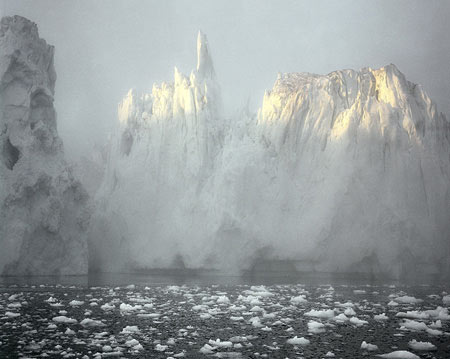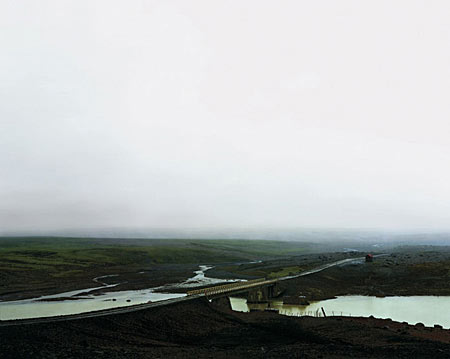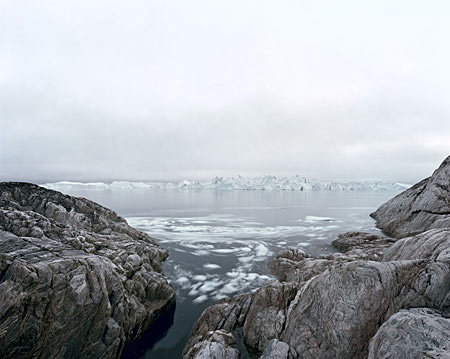A Conversation with Olaf Otto Becker

Olaf Otto Becker is one of my favourite landscape photographers. Given his new book Broken Line has just been released, I asked Olaf whether he would be up for a conversation, and I was very excited when he agreed to one.

Jörg Colberg: You last two series were done in Iceland and Greenland. What drew you to those places?
Olaf Otto Becker: After I took a lot of landscape photographs in Germany over a long period of time in an effort to understand my own surroundings, I was looking for a landscape where only few human beings lived. I was interested in a wild, unspoiled landscape. I was interested in a place where the landscape developed on its own. A place where the landscape was built and formed by water, wind, erosion, and only marginally by human beings using the wild land for their purposes. I wanted to explore landscape. I wanted to understand something about landscape.
When I arrived in Iceland for the first time, I was deeply impressed by the Nordic light. You can find similar light conditions in Germany as well, but only for a few minutes in the morning or in the evening. In Iceland, the light was mostly perfect the whole day, especially at night.
The colors were largely subdued with subtle nuances, nearly black and white at first glance, but astonishingly colorful at second glance.
These conditions enabled me to work with color like a painter. If I wanted to focus on green, grey white or blue, I was able to show it in thousands of nuances.

JC: When you were preparing for the series, how did you approach the projects? Did you have particular ideas in mind before shooting anything?
OOB: I had no idea before shooting. While traveling around, I was constantly astonished, always awake, with my eyes wide open and observing. The images met me. I did not look for photographs I already had in my mind.
JC: Here’s a question, which I think might be tricky to answer (maybe I’m wrong). When taking photos in Greenland - or maybe anywhere in the world - the danger always is that one ends up with something that looks like it’s out of National Geographic: Pretty photos that ultimately, however, are little more than decorative (at best) and kitschy (at worst). You managed to avoid this easily. How did you do this? Was this something you were concerned with at all?
OOB: I always ask myself what I essentially see, right there, right then. I try to understand what I see. I look for something that speaks by itself without captions. I try to let the landscape speak. I am not interested in things I have already seen. I try to look at something as though my eyes had opened for the first time and I try to understand what I see.

JC: There is a lot of talk of a German aesthetic, or maybe of a German approach to contemporary photography. I’d be curious to learn a little about your thoughts about this. From what you can tell, is there a German approach to photography? Is the German aesthetics different?
OOB: I am definitely influenced by my German education and surroundings, but I’m not the one to judge whether I am a typical German photographer. I am interested in the work of photographers from all over the world. American, Japanese, Finnish, French, Italian, German, British, Polish, Russian, Chinese…
Without a doubt, I am influenced by that what I have already experienced and seen. I strive to find my own position within our world. I try to add something new by using the means offered by photography.
JC: Is the reception of your work different abroad than in Germany? Or have you encountered the same reactions to it?
OOB: The reception of my work is indeed different abroad (especially in America) than in Germany, but interest is now rapidly growing also in Germany.

JC: And lastly about yourself, you studied communication design and later philosophy - not quite the photography background. How did your interest in photography develop, and what photographers would you give as inspiration for your own work?
OOB: When I was young, I painted for many years. I intended to study painting at an art school. When I was 19, I had what you might call a crisis with respect to my painting, and I decided
to stop painting forever. Suddenly, I was sure that it would not make sense to study art with the intention of becoming an artist.
I decided to study communication design. The wish to express what I am interested in remained, so I started to take photography seriously.
Initially, I took landscape photographs of my immediate surroundings with the intent to explore and understand them. I never had the desire to earn money with my photographs. I used the camera as a tool to understand the world around me.
The difference to painting was that a photograph has more to do with reality and I was interested in understanding my reality. I was often in doubt as to what reality meant. By means of taking photographs, I captured something that everybody could verify. In my series titled Broken Line I also recorded the GPS data of the location where I took the shot. Everybody is invited to have a look. Reality is sometimes astonishing, but what you see today will be changed tomorrow. So a photograph can help to understand the change.

I am inspired by a lot of photographers and artists, for example: Robert Adams, Lewis Baltz, Elina Brotherus, Edward Burtynsky, Gregory Conniff, William Christenberry, John Davies, Thekla Ehling, David Goldblatt, Paul Graham, NaoYa Hatakeyama, Roni Horn, Tiina Itkonen, Mark Klett, Nina Korhonen, Richard Misrach, Joel Meyerowitz, Sally Mann, Taiji Matsue, Matthew Monteith, Nicholas Nixon, Clare Richardson, Gerhard Richter, Martin Parr, Martin Puryear, Taryn Simon, Jem Southam, David Spero, Hiroshi Sugimoto, Hiromi Tsuchida, Sze Tsung Leong, Carleton Watkins, Francesca Woodman, Burk Uzzle, JoAnn Verburg, Bernard Voita, Zeng Li amongst others.
I can’t say there is this one photographer or painter who inspired me to go my way. The first time I encountered the work of great photographers and painters was 20 years ago. After that, a new inspiration came every month.
Today, I find something new nearly every day. But now I have the feeling I can go my own way, and I have fun watching others not far away going in the same direction.
 By
By